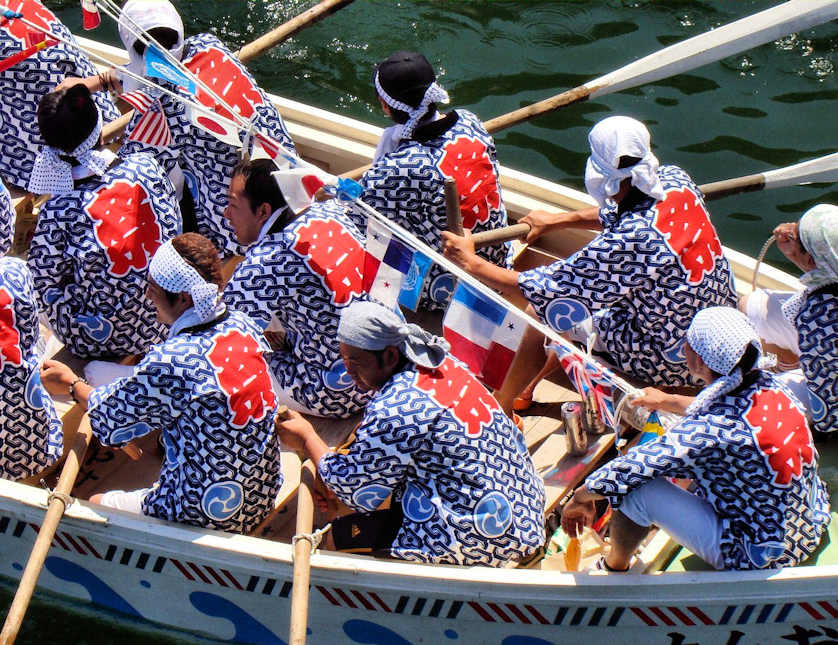Happi Coats はっぴ
 |
| Dancers in red happi coats with a kinchaku, a drawstring bag, hanging from their obi. Happi coats do not usually have pockets |
The kimono is obviously the best-known item of traditional and contemporary Japanese fashion, but various other garments are gaining prominence recently, chief among them the happi coat.
Most commonly seen on participants in summer festivals, the happi is a simple jacket, usually in bright, primary colors, with a simple design, although each of these features has started to change in modern times.
The happi coat is traditionally a jacket that commonly came down as far as the wearer's hips, though nowadays, especially among yosakoi dancers, longer versions are worn, some as long as down to the calves.
The sleeves are fairly wide and of varying lengths, but completely sleeveless is also possible. The happi is a wrap-around garment and is held by a narrow sash or obi like a kimono, though many times it is simply worn open. The happi is distinguished from the hanten, another kind of jacket that does not wrap-around and is closed using ties. The hanten is usually shorter and, being mostly cold weather wear, thicker and sometimes padded.
 |
| Japanese children wearing happi taking part in a festival |
History
Originally the happi seems to have been a kind of uniform, being worn by male servants and with the family mon, or crest, on the back of the garment.
Later other groups, like Edo firefighters, took to wearing it to identify themselves as members of a group, and sometimes in the Edo period women also took to wearing it.
Festival Wear
Nowadays it is most commonly associated with matsuri, festivals, and perhaps the most common style is with a simple, plain happi in one bold color with the kanji for matsuri (祭り) on the back.
At any festival, no matter how small, the people carrying the mikoshi, portable shrine, will all be wearing happi. In larger festivals where different communities "compete", each community will be wearing a different happi coat. Also in matsuri parades each different group of dancers will be wearing their own happi. As well as dance groups, music groups, like taiko troupes, will often wear happi coats as well.
 |
| The heri or lapel of a happi coat will often be a different color and carry the name of the group or organization |
Work Wear
Outside of festivals, workers in many "traditional" Japanese businesses may wear them, such as rickshaw pullers, or izakaya and sushi restaurant staff.
Increasingly happi are worn for civic events such as unveilings and event or building opening ceremonies, and in purely commercial situations, businesses and stores will have staff members wear happi featuring the company name worn for sales events and campaigns.
 |
| Members of a traditional taiko drumming group wearing happi coats sporting the group's name on the back. In this shot the three male drummers wear their happi loose, and the two females use an obi |
Material
Originally happi were made of cotton, but nowadays polyester and other man-made fibres are increasingly being used. Colors are usually bold, with bright blue and bright red being very common and black or white also popular.
Increasingly, especially with the dramatic rise of yosakoi dance groups who favor longer happi, a wider range of colors and combinations are now appearing.
The lapel, or heri, is usually a contrasting color (often black) and will often carry the name of the group. Decoration has traditionally been fairly simple with traditional emblems or patterns used in contrasting colors, but some happi use an all-over pattern, and increasingly varied decorations and color combinations can be found.
 |
| People carrying the shrine during a festival have always worn happi coats in Japan |
Purchase a Range of Happi Coats from Japan
Purchase a selection of happi coats from GoodsFromJapan
Or contact us if you wish to design your own happi coat
How to order a custom happi coat from Japan
Jake Davies
Gallery
 |
| Once quite limited, the designs and color schemes of happi coats are becoming increasingly varied |
 |
| Using increasingly varied color combinations and designs, happi coats are becoming even more popular in modern times |
 |
| Tsunagi, or chain-linked, traditional pattern is a common design used on happi coats |
Related
Daruma Dolls - History & Symbolism

No comments:
Post a Comment